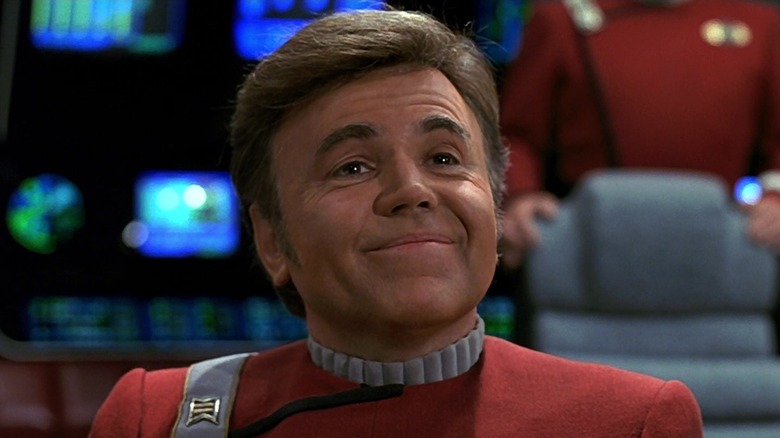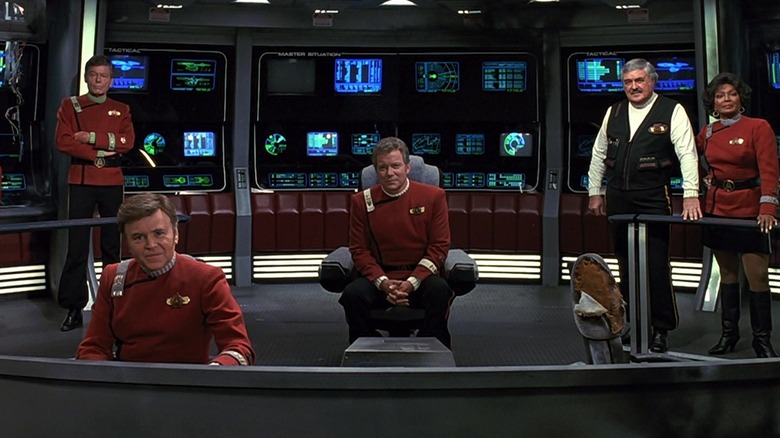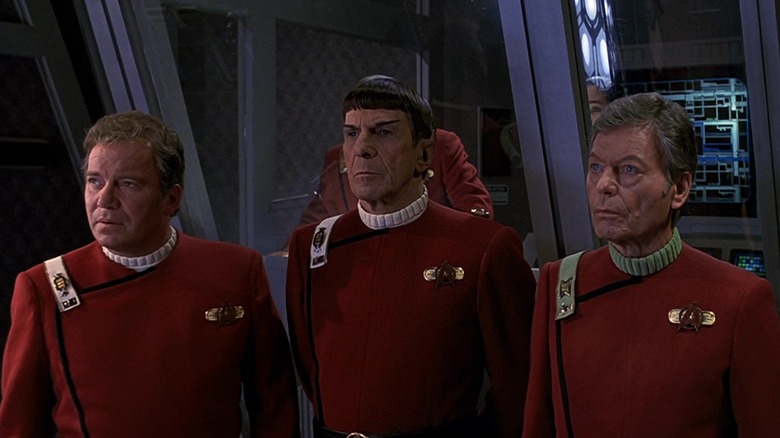Walter Koenig Wrote A Star Trek VI Pitch That Killed Off Multiple Main Characters
We may receive a commission on purchases made from links.
Thanks to their fictional captain, the original crew of the Starship Enterprise almost didn't get a fond big-screen farewell.
Prior to 1989, the starcrossed "Star Trek" franchise had survived network cancellation and a box office/critical disappointment in "Star Trek: The Motion Picture." As such, the brand was unexpectedly in terrific shape coming off three hits in a row in the 1980s with "Star Trek II: The Wrath of Khan," "Star Trek III: The Search for Spock," and "Star Trek IV: The Voyage Home." For once, it felt like the entire "Star Trek" team was playing with house money. Then William Shatner, having watched Leonard Nimoy take two turns at the helm, which earned him a hugely successful non-"Star Trek" directing effort in "Three Men and a Baby" (the highest grossing film of 1987), decided it was time to strut his stuff behind the camera.
The result was "Star Trek V: The Final Frontier," a film so poorly received critically and commercially that Paramount considered recasting the main roles with younger actors in a prequel set at Starfleet Academy.
The writing was on the wall at this point, and, in the case of some of the actors, their advancing ages were very much on the screen. They were fortunate to be getting one last adventure, and they knew it. They also understandably took this personally, which led Walter Koenig, a relative late-comer to the franchise (his character, Chekov, joined the bridge of the Enterprise in the original "Star Trek" TV show's second season), to step up and write a pitch for the sixth film. How did that work out for him?
The last mission of the Starship Enterprise
Walter Koenig's pitch was titled "Star Trek VI: In Flanders Fields." If you're familiar with World War I history, you can probably surmise that this was an unusually bloody –- or, at least, costly –- tale for the franchise.
Koenig's story, which he reprinted in his memoir "Warped Factors: A Neurotic's Guide to the Universe," opens with the Federation helping a Romulan civilization on the verge of catastrophe due to a mysterious natural disaster. This enrages the Klingons, so everyone goes to war. The Federation requires fitness evaluations before the ships are crewed up, which knocks all but Spock out of serving in this conflict. As the Federation wages a successful campaign, the old Enterprise crew members are scattered to the wind. They struggle to readjust to a world ready to move on without them.
Just as it appears that their Starfleet days are over, the Enterprise, whilst returning home from the war with the Klingons, goes missing. They've been ensnared by a race of worm-like monsters that feeds off the lifeforce of humans. Since Kirk, Uhura, Sulu, Chekov and Scotty are elderly, the worms have little interest in them. Instead, they're off to the worm planet to rescue Spock and the new crew of the Enterprise.
It's their last mission. They each give their lives as they attempt to free Spock from a dungeon. According to Koenig's pitch, Kirk is the final one to fall. Or so we think.
Spock and McCoy both live
McCoy unexpectedly reemerges and, though he's got just about nothing left in the tank, is able to reach Spock. Per Konig's pitch:
"Slowly, Spock raises his arm and McCoy reaches out for it, to help him rise to his feet. In this loneliest, most desolate of moments, Spock has permitted himself the one expression of friendship that he has never before admitted to: his need of Leonard McCoy. Spock leans against the doctor for support, and the two men — adversaries in a thousand arguments over the years — walk off together."
Obviously, the "Star Trek" creatives went in a different direction with "Star Trek VI: The Undiscovered Country," which wisely let "Star Trek II: The Wrath of Kahn" director Nicholas Meyer guide the Enterprise back to safe harbor, with everyone accounted for, one last time (though they did borrow the idea of an enemy in need, opting for the Klingons instead of the Romulans). The baton was subsequently passed to the "Next Generation" crew for four films, though Shatner found a way to wedge himself into one more movie. Yes, Nimoy got to appear in 2009's "Star Trek" and its sequel "Star Trek Into Darkness," but that was one of the few unforced elements of that very entertaining yet otherwise strangely stakes-less film.


